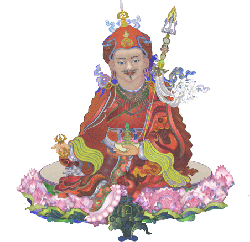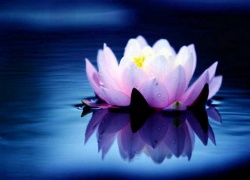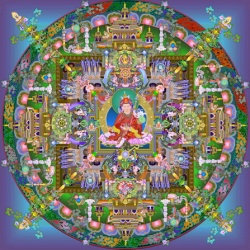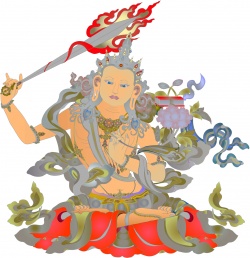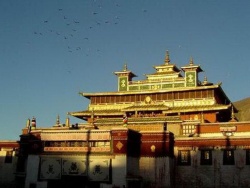Difference between revisions of "Mahayoga"
m (Text replacement - "{{Wiki|related}}" to "related") |
|||
| Line 1: | Line 1: | ||
[[File:Padma VTao.gif|thumb|250px|]] | [[File:Padma VTao.gif|thumb|250px|]] | ||
<poem> | <poem> | ||
| + | |||
| + | |||
| + | |||
| + | |||
| + | |||
| + | #REDIRECT[[]] | ||
[[Mahayoga]] (Skt. [[mahāyoga]]; Tib. {{BigTibetan|[[རྣལ་འབྱོར་ཆེན་པོ་]]}}, [[naljor chenpö]], [[Wyl.]] [[rnal 'byor chen po]]) — the first of the [[three yanas of powerful transformative methods]] according to the nine [[yana]] {{Wiki|classification}} of the [[Nyingma school]]. | [[Mahayoga]] (Skt. [[mahāyoga]]; Tib. {{BigTibetan|[[རྣལ་འབྱོར་ཆེན་པོ་]]}}, [[naljor chenpö]], [[Wyl.]] [[rnal 'byor chen po]]) — the first of the [[three yanas of powerful transformative methods]] according to the nine [[yana]] {{Wiki|classification}} of the [[Nyingma school]]. | ||
| Line 6: | Line 12: | ||
---- | ---- | ||
The first of the '[[Three Inner Tantras]].' [[Mahayoga]] as [[scripture]] is divided into two parts: [[Tantra Section]] and [[Sadhana Section]]. The [[Tantra Section]] consists of the [[Eighteen Mahayoga Tantras]] while the [[Sadhana Section]] is comprised of the [[Eight Sadhana Teachings]]. <br> | The first of the '[[Three Inner Tantras]].' [[Mahayoga]] as [[scripture]] is divided into two parts: [[Tantra Section]] and [[Sadhana Section]]. The [[Tantra Section]] consists of the [[Eighteen Mahayoga Tantras]] while the [[Sadhana Section]] is comprised of the [[Eight Sadhana Teachings]]. <br> | ||
| − | [[Jamgön Kongtrül]] says in his [[Treasury of Knowledge]]: "[[Mahayoga]] emphasizes means ([[upaya]]), the [[development stage]], and the [[view]] that [[liberation]] is attained through growing accustomed to the [[insight]] into the [[nature]] of the [[indivisibility]] of the {{Wiki|superior}} [[two truths]]." <br> | + | [[Jamgön Kongtrül]] says in his [[Treasury of Knowledge]]: "[[Mahayoga]] emphasizes means ([[upaya]]), the [[development stage]], and the [[view]] that [[liberation]] is [[attained]] through growing accustomed to the [[insight]] into the [[nature]] of the [[indivisibility]] of the {{Wiki|superior}} [[two truths]]." <br> |
The [[superior two truths]] in [[Mahayoga]] are [[purity and equality]] — the [[pure]] natures of the [[aggregates]], [[elements]] and factors of [[the senses]] are the {{Wiki|male}} and {{Wiki|female}} [[buddhas]] and [[bodhisattvas]]. At the same [[time]], everything which appears and [[exists]] is of the {{Wiki|equal}} [[nature]] of [[emptiness]]. | The [[superior two truths]] in [[Mahayoga]] are [[purity and equality]] — the [[pure]] natures of the [[aggregates]], [[elements]] and factors of [[the senses]] are the {{Wiki|male}} and {{Wiki|female}} [[buddhas]] and [[bodhisattvas]]. At the same [[time]], everything which appears and [[exists]] is of the {{Wiki|equal}} [[nature]] of [[emptiness]]. | ||
| Line 20: | Line 26: | ||
[[View]] | [[View]] | ||
| − | By means of [[extraordinary]] lines of {{Wiki|reasoning}}, one establishes and then realizes the [[indivisibility]] of the [two] higher levels of [[reality]], according to which the [[cause]] for the [[appearance]] of the [[essential]] [[nature]], the seven riches of the [[absolute]], is spontaneously {{Wiki|present}} within the [[pure]] [[awareness]] that is [[beyond]] {{Wiki|conceptual}} elaboration, and all [[relative]] [[phenomena]] naturally appear as the [[mandala]] of [[deities]] of the three seats. | + | By means of [[extraordinary]] lines of {{Wiki|reasoning}}, one establishes and then realizes the [[indivisibility]] of the [two] higher levels of [[reality]], according to which the [[cause]] for the [[appearance]] of the [[essential]] [[nature]], the [[seven riches]] of the [[absolute]], is spontaneously {{Wiki|present}} within the [[pure]] [[awareness]] that is [[beyond]] {{Wiki|conceptual}} [[elaboration]], and all [[relative]] [[phenomena]] naturally appear as the [[mandala]] of [[deities]] of the three seats. |
[[Meditation]] | [[Meditation]] | ||
| − | When it comes to the [[path]] and the practice of [[meditation]]e main emphasis is on the [[generation stage]]. In the practice of [[generation stage]] [[yoga]], one sets up the practice through the three [[samadhis]], ensures that the three of purifying, perfecting and ripening are complete within the [[visualization]], and, once the [[visualization]] is complete, [[seals]] it with the instruction on the four nails securing the {{Wiki|life-force}}. In the practice of the [[completion stage]] [[yoga]], one activates the [[vital]] points of the [[vajra body]], its {{Wiki|subtle}} energies, [[essences]], [[luminosity]] and so on. | + | When it comes to the [[path]] and the practice of [[meditation]]e main {{Wiki|emphasis}} is on the [[generation stage]]. In the practice of [[generation stage]] [[yoga]], one sets up the practice through the three [[samadhis]], ensures that the three of purifying, perfecting and ripening are complete within the [[visualization]], and, once the [[visualization]] is complete, [[seals]] it with the instruction on the four [[nails]] securing the {{Wiki|life-force}}. In the practice of the [[completion stage]] [[yoga]], one activates the [[vital]] points of the [[vajra body]], its {{Wiki|subtle}} energies, [[essences]], [[luminosity]] and so on. |
Conduct | Conduct | ||
| Line 36: | Line 42: | ||
The [[Mahayoga]] teachings belong either to: | The [[Mahayoga]] teachings belong either to: | ||
| − | the [[tantra]] class (Tib. {{BigTibetan|[[རྒྱུད་སྡེ་]]}}, [[gyüdé]]; Wyl. [[rgyud sde]]) or | + | the [[tantra]] class (Tib. {{BigTibetan|[[རྒྱུད་སྡེ་]]}}, [[gyüdé]]; [[Wyl.]] [[rgyud sde]]) or |
the [[sadhana]] class (Tib. {{BigTibetan|[[སྒྲུབ་སྡེ་]]}}, [[drupdé]]; [[Wyl.]] [[sgrub sde]]). | the [[sadhana]] class (Tib. {{BigTibetan|[[སྒྲུབ་སྡེ་]]}}, [[drupdé]]; [[Wyl.]] [[sgrub sde]]). | ||
| Line 60: | Line 66: | ||
The [[lineage]] of these teachings starts in the [[Akanishtha heaven]] with the [[mind]] direct [[transmission]] of the [[Primordial Buddha]] [[Samantabhadra]] to the [[buddhas]] of the [[five families]] and [[sambhogakaya]] [[buddhas]] and [[bodhisattvas]] of their retinue such as the [[lords of the three families]]. | The [[lineage]] of these teachings starts in the [[Akanishtha heaven]] with the [[mind]] direct [[transmission]] of the [[Primordial Buddha]] [[Samantabhadra]] to the [[buddhas]] of the [[five families]] and [[sambhogakaya]] [[buddhas]] and [[bodhisattvas]] of their retinue such as the [[lords of the three families]]. | ||
| − | The [[lineage]] then continued through the sign [[transmission]] of the [[vidyadharas]] with [[Avalokiteshvara]] giving these teachings to the [[nagas]], [[Manjushri]] to the [[gods]] and [[Vajrapani]] to the [[yakshas]]. [[Vajrapani]] also taught the [[human]] {{Wiki|Licchavi}} [[Vimalakirti]] ([[Wyl.]] [[li tsa ba dri med grags pa]])—one of the Five {{Wiki|Excellent}} Ones of [[Sublime]] Nobility—at the summit of [[Mount Malaya]]. | + | The [[lineage]] then continued through the sign [[transmission]] of the [[vidyadharas]] with [[Avalokiteshvara]] giving these teachings to the [[nagas]], [[Manjushri]] to the [[gods]] and [[Vajrapani]] to the [[yakshas]]. [[Vajrapani]] also [[taught]] the [[human]] {{Wiki|Licchavi}} [[Vimalakirti]] ([[Wyl.]] [[li tsa ba dri med grags pa]])—one of the Five {{Wiki|Excellent}} Ones of [[Sublime]] Nobility—at the summit of [[Mount Malaya]]. |
[[File:Vajra2.JPG|thumb|250px|]] | [[File:Vajra2.JPG|thumb|250px|]] | ||
| − | A central figure in the [[transmission]] of the [[Mahayoga]] teachings in our [[human world]] was [[King]] [[Dza]] who found on the roof of his palace the eighteen [[tantras]] of [[Mahayoga]] and a statue of [[Vajrapani]]. After praying to [[Vajrapani]], he was able to understand the chapter known as The [[Vision]] of [[Vajrasattva]]. He practised for six months, using that chapter and the statue of [[Vajrapani]] as the support for his [[meditation]]. He then had a [[vision]] of [[Vajrasattva]], who blessed him so that he understood perfectly the meaning of all the [[tantras]] he received. | + | A central figure in the [[transmission]] of the [[Mahayoga]] teachings in our [[human world]] was [[King]] [[Dza]] who found on the roof of his palace the eighteen [[tantras]] of [[Mahayoga]] and a statue of [[Vajrapani]]. After praying to [[Vajrapani]], he was able to understand the [[chapter]] known as The [[Vision]] of [[Vajrasattva]]. He practised for six months, using that [[chapter]] and the statue of [[Vajrapani]] as the support for his [[meditation]]. He then had a [[vision]] of [[Vajrasattva]], who blessed him so that he understood perfectly the meaning of all the [[tantras]] he received. |
| − | [[King]] Dza also received the [[oral transmission]] of these teachings from the {{Wiki|Licchavi}} [[Vimalakirti]]. The [[lineage]] was then passed on to the great [[siddha]] [[Kukkuraja]], and then via [[Buddhaguhya]] to [[Vimalamitra]] and [[Padmasambhava]], who taught them to their [[Tibetan]] [[disciples]]. | + | [[King]] Dza also received the [[oral transmission]] of these teachings from the {{Wiki|Licchavi}} [[Vimalakirti]]. The [[lineage]] was then passed on to the great [[siddha]] [[Kukkuraja]], and then via [[Buddhaguhya]] to [[Vimalamitra]] and [[Padmasambhava]], who [[taught]] them to their [[Tibetan]] [[disciples]]. |
[[Nyak Jñanakumara]] received the [[transmission]] of the [[Mahayoga]] teachings from both [[Vimalamitra]] and [[Guru Rinpoche]]; he collaborated in the translation of [[tantras]] of the Web of [[Magical]] [[Illusion]] and thus played an important role in the early [[transmission]] of the [[mahayoga]] [[lineage]]. | [[Nyak Jñanakumara]] received the [[transmission]] of the [[Mahayoga]] teachings from both [[Vimalamitra]] and [[Guru Rinpoche]]; he collaborated in the translation of [[tantras]] of the Web of [[Magical]] [[Illusion]] and thus played an important role in the early [[transmission]] of the [[mahayoga]] [[lineage]]. | ||
| Line 73: | Line 79: | ||
| − | [[Mahayoga]] is called the “great [[yoga]]” because it brings [[realization]] of [[non-duality]]. Its gateway consists of four main [[empowerments]]: the vase, the secret, the [[wisdom]], and the [[symbolic]] (or [[word]]) [[empowerment]]. These {{Wiki|purify}} the [[defilements]] of the [[body]], [[speech]] and [[mind]], as well as their {{Wiki|subtle}} [[obscurations]], and enable the [[practitioner]] to realize the [[Four Kayas]], respectively. | + | [[Mahayoga]] is called the “great [[yoga]]” because it brings [[realization]] of [[non-duality]]. Its gateway consists of four main [[empowerments]]: the [[vase]], the secret, the [[wisdom]], and the [[symbolic]] (or [[word]]) [[empowerment]]. These {{Wiki|purify}} the [[defilements]] of the [[body]], [[speech]] and [[mind]], as well as their {{Wiki|subtle}} [[obscurations]], and enable the [[practitioner]] to realize the [[Four Kayas]], respectively. |
[[View]]: [[Awareness]], free from {{Wiki|conceptual}} limitations, is regarded as [[absolute truth]] and inherently endowed with all [[enlightened qualities]]. All [[phenomena]] – the outer [[universe]], the various {{Wiki|psychophysical}} [[elements]] of the [[body]] as well as [[thoughts]] – arise as a [[mandala]] which stands for [[relative truth]]. The [[two truths]] – [[emptiness]] and [[phenomena]] – are [[inseparable]], like {{Wiki|gold}} and its {{Wiki|color}}. | [[View]]: [[Awareness]], free from {{Wiki|conceptual}} limitations, is regarded as [[absolute truth]] and inherently endowed with all [[enlightened qualities]]. All [[phenomena]] – the outer [[universe]], the various {{Wiki|psychophysical}} [[elements]] of the [[body]] as well as [[thoughts]] – arise as a [[mandala]] which stands for [[relative truth]]. The [[two truths]] – [[emptiness]] and [[phenomena]] – are [[inseparable]], like {{Wiki|gold}} and its {{Wiki|color}}. | ||
| − | [[Meditation]]: [[Mahayoga]] emphasizes the [[development stage]] which focuses on the process of [[visualization]]. The [[practitioner]] sees herself as a [[deity]] who is the very [[manifestation]] of her own [[wisdom]] [[nature]]. The outer [[world]] is seen as a [[buddhafield]] and the [[beings]] therein as {{Wiki|male}} and [[female deities]]. These methods help the [[practitioner]] to [[recognize]] the [[primordial]], [[unchanging]] [[purity]] of [[phenomena]] that is the true [[condition]] of all things. | + | [[Meditation]]: [[Mahayoga]] emphasizes the [[development stage]] which focuses on the process of [[visualization]]. The [[practitioner]] sees herself as a [[deity]] who is the very [[manifestation]] of her [[own]] [[wisdom]] [[nature]]. The outer [[world]] is seen as a [[buddhafield]] and the [[beings]] therein as {{Wiki|male}} and [[female deities]]. These methods help the [[practitioner]] to [[recognize]] the [[primordial]], [[unchanging]] [[purity]] of [[phenomena]] that is the true [[condition]] of all things. |
The [[practitioner]] also engages in the [[completion stage]] that is related to the [[subtle channels]] ([[nadi]]), [[energy]] ([[prana]]), and [[essence]] ([[bindu]]). [[Formless]] [[meditation]] involves merging the [[mind]] with the profound, [[absolute]] [[nature]]. | The [[practitioner]] also engages in the [[completion stage]] that is related to the [[subtle channels]] ([[nadi]]), [[energy]] ([[prana]]), and [[essence]] ([[bindu]]). [[Formless]] [[meditation]] involves merging the [[mind]] with the profound, [[absolute]] [[nature]]. | ||
| Line 83: | Line 89: | ||
[[Action]]: With [[confidence]] cultivated through [[skillful means]] such as [[devotion]] and [[pure]] [[perception]], without rejection or [[attachment]] the [[practitioner]] uses [[samsaric]] [[experience]] as a catalyst to foster the practice. | [[Action]]: With [[confidence]] cultivated through [[skillful means]] such as [[devotion]] and [[pure]] [[perception]], without rejection or [[attachment]] the [[practitioner]] uses [[samsaric]] [[experience]] as a catalyst to foster the practice. | ||
| − | Fruit: [[Realization]] is attained within this [[lifetime]] or in the ensuing [[bardo]], the transitional state between [[death]] and [[rebirth]]. | + | Fruit: [[Realization]] is [[attained]] within this [[lifetime]] or in the ensuing [[bardo]], the [[transitional state]] between [[death]] and [[rebirth]]. |
</poem> | </poem> | ||
{{R}} | {{R}} | ||
Revision as of 05:23, 22 December 2015
- REDIRECT[[]]
Mahayoga (Skt. mahāyoga; Tib. རྣལ་འབྱོར་ཆེན་པོ་, naljor chenpö, Wyl. rnal 'byor chen po) — the first of the three yanas of powerful transformative methods according to the nine yana classification of the Nyingma school.
Mahayoga (rnal 'byor chen po).
The first of the 'Three Inner Tantras.' Mahayoga as scripture is divided into two parts: Tantra Section and Sadhana Section. The Tantra Section consists of the Eighteen Mahayoga Tantras while the Sadhana Section is comprised of the Eight Sadhana Teachings.
Jamgön Kongtrül says in his Treasury of Knowledge: "Mahayoga emphasizes means (upaya), the development stage, and the view that liberation is attained through growing accustomed to the insight into the nature of the indivisibility of the superior two truths."
The superior two truths in Mahayoga are purity and equality — the pure natures of the aggregates, elements and factors of the senses are the male and female buddhas and bodhisattvas. At the same time, everything which appears and exists is of the equal nature of emptiness.
Mahayoga focuses mainly on the development stage (Tib. kyérim), and emphasizes the clarity and precision of visualization as skilful means.
Overview Given by Alak Zenkar Rinpoche
The vehicle of mahayoga, or ‘great yoga,’ is so-called because it is superior to ordinary yoga tantra since all phenomena are realized to be a magical display in which appearance and emptiness are indivisible.
Entry Point
Once one’s mind has been matured through receiving the ten outer benefiting empowerments, the five inner enabling empowerments and the three secret profound empowerments , one keeps the samayas as they are described in the texts.
View
By means of extraordinary lines of reasoning, one establishes and then realizes the indivisibility of the [two] higher levels of reality, according to which the cause for the appearance of the essential nature, the seven riches of the absolute, is spontaneously present within the pure awareness that is beyond conceptual elaboration, and all relative phenomena naturally appear as the mandala of deities of the three seats.
Meditation
When it comes to the path and the practice of meditatione main emphasis is on the generation stage. In the practice of generation stage yoga, one sets up the practice through the three samadhis, ensures that the three of purifying, perfecting and ripening are complete within the visualization, and, once the visualization is complete, seals it with the instruction on the four nails securing the life-force. In the practice of the completion stage yoga, one activates the vital points of the vajra body, its subtle energies, essences, luminosity and so on.
Conduct
One maintains elaborate, unelaborate and extremely unelaborate conduct.
Results
In the short term one reaches the four vidyadhara levels, which are the results belonging to the path, and finally one gains the ultimate fruition, and reaches the level of the Vajradhara of unity.
Subdivisions
The Mahayoga teachings belong either to:
the tantra class (Tib. རྒྱུད་སྡེ་, gyüdé; Wyl. rgyud sde) or
the sadhana class (Tib. སྒྲུབ་སྡེ་, drupdé; Wyl. sgrub sde).
The sadhana class itself is further subdivided into:
kama section and
terma section.
Mahayoga can also be divided into three classes:
Maha of Maha (Wyl. maha'i maha)
Anu of Maha
Ati of Maha
Texts of the Mahayoga
The tantra class contains eighteen tantras, of which the Guhyagarbha Tantra is the root tantra. (Nyingma Gyübum Dergé ed. vols. 9-14, Tingkyé ed. vols. 14-19)
The sadhana class has five main sections, corresponding to the five wisdom deities of the Kagyé, to which three sections corresponding to the three semi-worldly or worldly deities of the Kagyé are added. (Dergé ed. vols. 15-24, Tingkyé ed. vols. 20-33)
In addition, for the sadhana class, volumes 31 and 32 of the Tingkyé edition of the Nyingma Gyübum respectively contain the general tantras (Wyl. spyi rgyud) and the particular tantras (Wyl. sgos rgyud) associated with the original Indian terma recension of the Tantra of the Gathering of the Sugatas of the Kagyé (Wyl. sgrub chen bka' brgyad dbe 'dus kyi rgyud), from which the later Tibetan terma cycles of the Kagyé derive.
The Lineage of the Tantra Class of Mahayoga
The lineage of these teachings starts in the Akanishtha heaven with the mind direct transmission of the Primordial Buddha Samantabhadra to the buddhas of the five families and sambhogakaya buddhas and bodhisattvas of their retinue such as the lords of the three families.
The lineage then continued through the sign transmission of the vidyadharas with Avalokiteshvara giving these teachings to the nagas, Manjushri to the gods and Vajrapani to the yakshas. Vajrapani also taught the human Licchavi Vimalakirti (Wyl. li tsa ba dri med grags pa)—one of the Five Excellent Ones of Sublime Nobility—at the summit of Mount Malaya.
A central figure in the transmission of the Mahayoga teachings in our human world was King Dza who found on the roof of his palace the eighteen tantras of Mahayoga and a statue of Vajrapani. After praying to Vajrapani, he was able to understand the chapter known as The Vision of Vajrasattva. He practised for six months, using that chapter and the statue of Vajrapani as the support for his meditation. He then had a vision of Vajrasattva, who blessed him so that he understood perfectly the meaning of all the tantras he received.
King Dza also received the oral transmission of these teachings from the Licchavi Vimalakirti. The lineage was then passed on to the great siddha Kukkuraja, and then via Buddhaguhya to Vimalamitra and Padmasambhava, who taught them to their Tibetan disciples.
Nyak Jñanakumara received the transmission of the Mahayoga teachings from both Vimalamitra and Guru Rinpoche; he collaborated in the translation of tantras of the Web of Magical Illusion and thus played an important role in the early transmission of the mahayoga lineage.
Alongside this long kama lineage is also the short terma lineage of Guru Rinpoche. Mahayoga teachings and sadhanas related to the Guhyagarbha Tantra have, for example, been revealed in the termas of Chokgyur Dechen Lingpa and Khenpo Jikme Phuntsok.
An extensive chronological list of lineage holders of the Mahayoga, from Buddha Samantabhadra to the present day, can be found in Tulku Thondup's works. (see reference below)
Mahayoga is called the “great yoga” because it brings realization of non-duality. Its gateway consists of four main empowerments: the vase, the secret, the wisdom, and the symbolic (or word) empowerment. These purify the defilements of the body, speech and mind, as well as their subtle obscurations, and enable the practitioner to realize the Four Kayas, respectively.
View: Awareness, free from conceptual limitations, is regarded as absolute truth and inherently endowed with all enlightened qualities. All phenomena – the outer universe, the various psychophysical elements of the body as well as thoughts – arise as a mandala which stands for relative truth. The two truths – emptiness and phenomena – are inseparable, like gold and its color.
Meditation: Mahayoga emphasizes the development stage which focuses on the process of visualization. The practitioner sees herself as a deity who is the very manifestation of her own wisdom nature. The outer world is seen as a buddhafield and the beings therein as male and female deities. These methods help the practitioner to recognize the primordial, unchanging purity of phenomena that is the true condition of all things.
The practitioner also engages in the completion stage that is related to the subtle channels (nadi), energy (prana), and essence (bindu). Formless meditation involves merging the mind with the profound, absolute nature.
Action: With confidence cultivated through skillful means such as devotion and pure perception, without rejection or attachment the practitioner uses samsaric experience as a catalyst to foster the practice.
Fruit: Realization is attained within this lifetime or in the ensuing bardo, the transitional state between death and rebirth.
